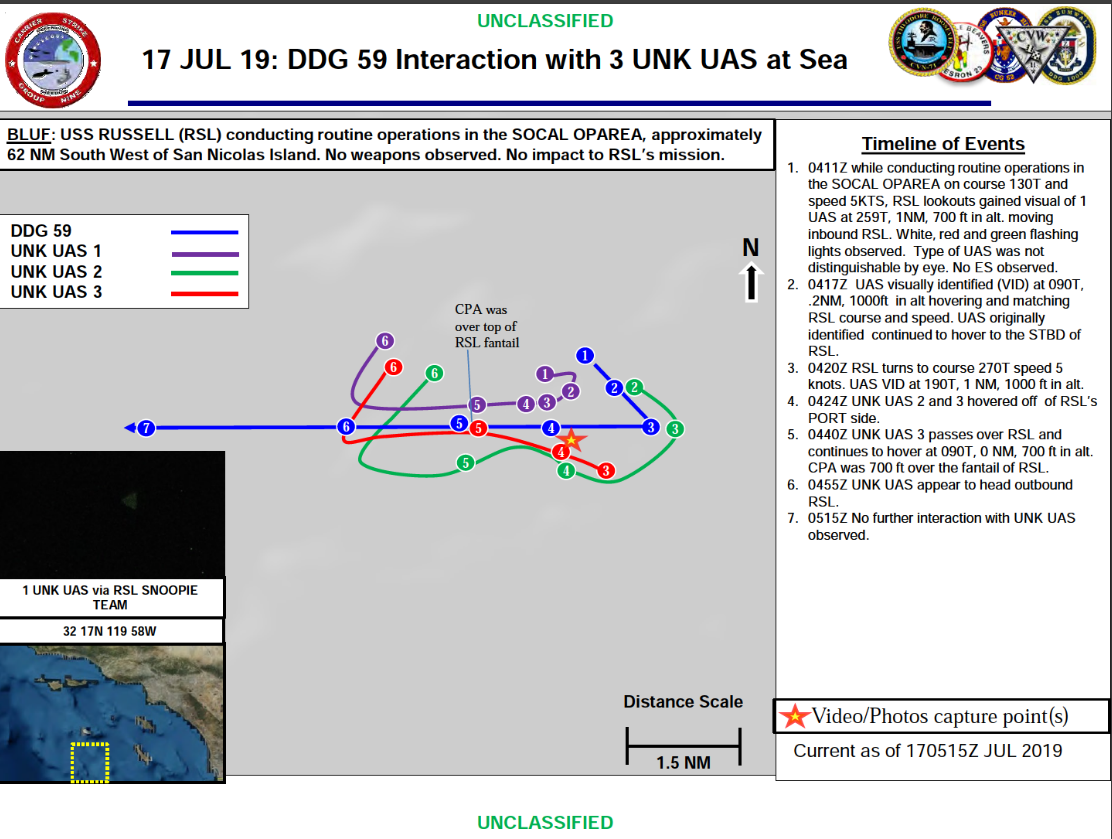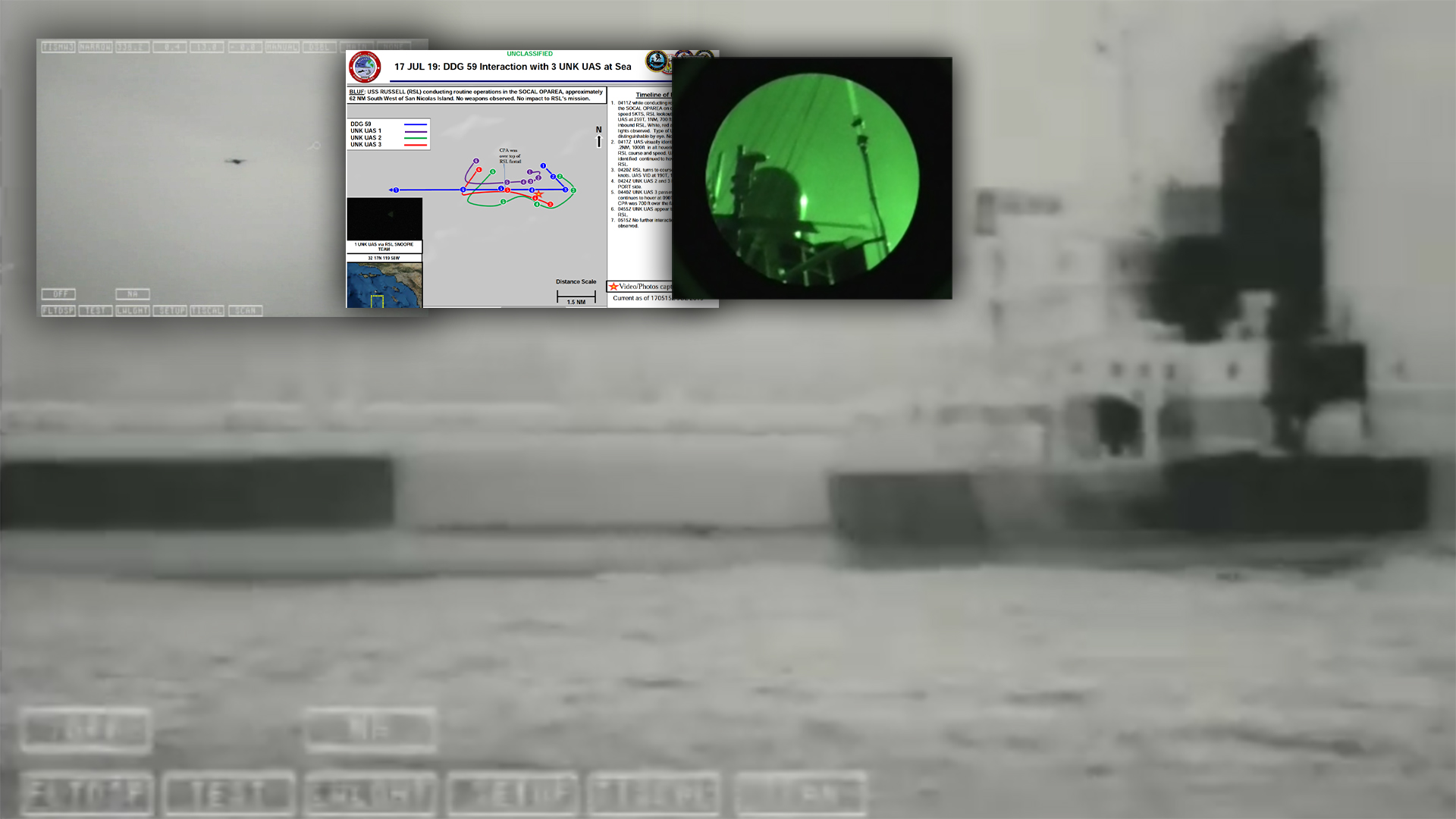Last week The War Zone reported a significant update in our ongoing investigation into a strange series of drone swarm incidents that occurred near U.S. Navy vessels off the coast of Southern California in 2019. A new release of documents via the Freedom of Information Act provided the greatest level of detail yet about what happened during the incidents. The documents we received last week made references to video files included in the briefs, five of which we have obtained from the Navy today.
Readers unfamiliar with the incident should read our longer piece here, which provides a great deal of additional detail and context on the events.
Two of the videos were taken from the USS Russell, a destroyer that has been of particular interest due to leaked videos of the incident released last year. The unusual appearance of the objects in the videos led to widespread speculation that they were “flying pyramid” UFOs due to their triangular shape. In a recent congressional hearing about unidentified aerial phenomena, Deputy Director for Naval Intelligence Scott Bray explained that “the triangular appearance is a result of light passing through the night vision goggles, and then being recorded by an SLR camera.” Similar assessments were quickly made by independent civilian researchers when the videos were leaked in 2021. While Bray’s testimony and further documentation have cleared up that these objects were drones, it remains unknown exactly who was operating them.
In the first video taken during an incident on July 17th, a sailor’s voice can be heard narrating the location of the ship. The sailor identifies himself as the SNOOPIE team leader. SNOOPIE refers to Ship Nautical Or Otherwise Photographic Interpretation and Exploitation team. These teams consist of sailors trained to conduct onboard photographic intelligence in order to document unknown contacts and events of interest. The sailor can be heard saying, “we have visual of four probable unidentified drones, with course unknown and speed unknown. Contacts are operating at a range of a thousand yards, and holding. Tail numbers are unknown.”

In our previous coverage, we published this briefing slide detailing the incident. Note that the USS Russell is also referred to by its hull number, DDG-59, and the abbreviation RSL:

A second video was taken from the USS Russell on July 30th. The SNOOPIE team leader again narrates the time and location. He identifies the object as “one possible UAS.” He states,”contact is operating at a range of 4000 yards. Flashing red, green and white solid lights seen.”

A second video was captured that day by the USS Paul Hamilton. In the following video, a voice can be heard narrating that “there are multiple UAS in the vicinity of Paul Hamilton, CPA 100 feet in altitude off the bow.” The acronym CPA stands for “closest point of approach.”

Two additional videos were released to us, though they are far less clear. The first of these videos was captured by the USS Paul Hamilton and shows footage of the Bass Strait, a Hong Kong-flagged bulk carrier. Documents from our previous update show that the Navy believed that the Bass Strait was “likely using UAVs to conduct surveillance on US Naval Forces.”

Finally, an unclear and low-resolution video from the USS Ralph Johnson shows what appears to be FLIR footage of a single distant object. Narration states that the object came within four nautical miles of the ship at the closest approach, and that the “interaction to this point has been safe and professional.”

These videos offer a very limited and controlled look into what occurred during these incidents. As unclassified products, they do not necessarily contain the full extent of information captured by the Navy. Certainly, the Navy ships involved host some of the most advanced sensors on earth, including radar, electronic surveillance, sonar, and electro-optical/infrared types, that can record multiple types of high-fidelity data — that is if they are up and running.
Though these videos will not necessarily answer all of the questions still surrounding these incidents, they are an additional piece of the puzzle. Perhaps the most significant aspect of the release is that the Navy has shown increasing openness about these incidents through the Freedom of Information Act process in recent months, and very promptly responded to our inquiry about the videos referenced in the previous set of documents. We will continue to update the story as we learn more.
